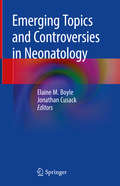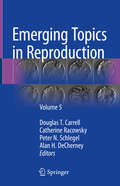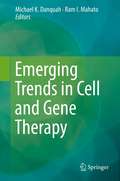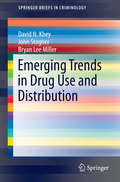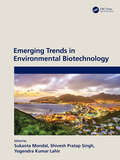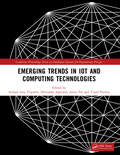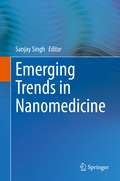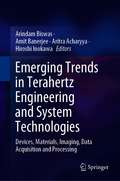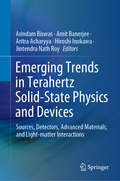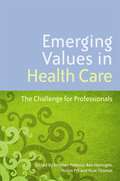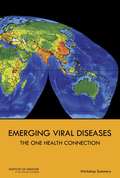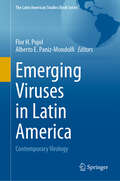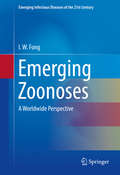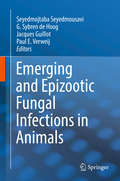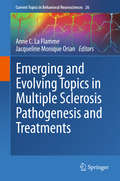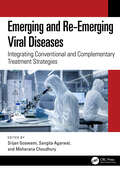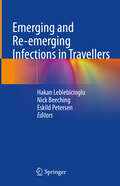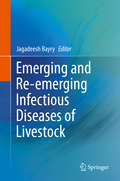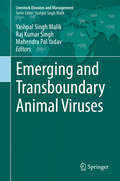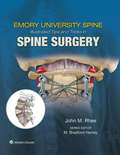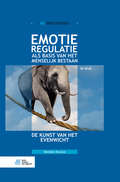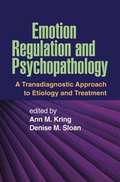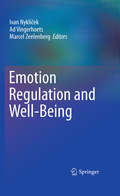- Table View
- List View
Emerging Topics and Controversies in Neonatology
by Elaine M. Boyle Jonathan CusackThis textbook addresses the themes that are at the forefront of neonatal clinical care and research, based on natural divisions in care during pregnancy, and postnatally by gestational age at birth. The book offers a unique approach, in that it proposes discussion of important general principles underpinning neonatal care that are not addressed in most general neonatology textbooks, such as ethical issues, counselling, effective training methods, quality and safety, among other subjects. These are fundamental aspects and challenges that need to be appreciated by senior clinicians. A chapter authored by parents describing their perspectives of neonatal intensive care is unique and will be highly educational, with the potential to influence the way in which individuals view and deliver neonatal care. The authors discuss common and important conditions, to promote adoption of sound evidenced based practice where this is available. However, where evidence is limited, as is the case in many areas of neonatal practice, the authors aim to encourage critical thinking and evidence appraisal, which are necessary skills for busy clinicians wishing to filter evidence to guide delivery of care. This text is suitable for senior trainees wishing to pursue a career in neonatal medicine, early career neonatologists and paediatricians with an interest in neonatology. It is also of interest to established neonatologists wishing to update their neonatal knowledge. The content is based on the RCPCH Level 3 curriculum, and addresses important topical and/or controversial aspects of neonatal care.
Emerging Topics in Reproduction: Volume 5
by Douglas T. Carrell Peter N. Schlegel Catherine Racowsky Alan H. DeCherneyPreviously known as Biennial Review of Infertility, the fifth installment in this series brings together the most current research and clinical evidence on male and female infertility, emerging assisted reproductive technologies (ART) and evolving controversies in reproductive medicine. In this latest volume, parts one and two discuss recent developments in male and female infertility respectively, including fertility preservation in the male adolescent cancer patient, the clinical relevance of sperm RNA, the management of subclinical hypothyroidism, and the effects of endocrine-disrupting chemicals. Part three covers the latest in ART, such as evidence-based morphological approaches for embryo selection and culturing human embryos. The final section highlights controversies in reproductive medicine, including the use of preimplantation genetic screening (PGS) and blastocyst transfer, as well as the ethics surrounding a maximum BMI for IVF. Providing an ongoing appraisal of current knowledge, and featuring contributions from leading experts in the field, Emerging Topics in Reproduction, Volume 5 is a worthy addition to the series and an ideal resource on the latest topics for reproductive medicine and REI specialists, OB-GYNS, andrologists, and any clinician working with infertility.
Emerging Trends in Cell and Gene Therapy
by Ram I. Mahato Michael K. DanquahExamples from various organs and diseases illustrate the potential benefit obtained when both therapeutic approaches are combined with delivery strategies. Representing the combined effort of several leading international research and clinical experts, this book, Emerging Trends in Cell and Gene Therapy, provides a complete account on and brings into sharp focus current trends and state-of-the-art in important areas at the interface of cell- and gene-based therapies. This book addresses the current fragmented understanding regarding these two research areas and fills the vast unmet educational need and interest of both students and researchers in academia and industry. Main features of the book: · Biological aspects of stem cell sources, differentiation and engineering. · Application of microfluidics to study stem cell dynamics · Potential clinical application of stem cells and gene therapy to specific human disease. · Utilization of biomaterials and stem cells in regenerative medicine with particular emphasis on spinal cord repair, ligament and bone tissue engineering. · Biomimetic multiscale topography for cell alignment.
Emerging Trends in Drug Use and Distribution
by David N. Khey John Stogner Bryan Lee MillerThis Brief explores emerging trends in drug use and distribution. This timely Brief examines recent examples of emerging drugs including salvia (from the plant Salvia divinorum), bath salts (and other synthetic stimulants) and so-called research chemicals (primarily substituted phenethylamines, synthetic cousins of ecstasy), which have tended to receive brief levels of high intensity media coverage that may or may not reflect an actual increase in their usage. Over the past decade in particular, "new" substances being used recreationally seem to come out of obscurity and gain rapid popularity, particularly spurred on by discussion and distribution over the internet. While changing trends in the drug market have always presented a challenge for law enforcement and public health officials, online forums, media coverage and other recent trends discussed in this Brief allow them to gain popularity more quickly and change more frequently. These rapid shifts allow less time for researchers to understand the potential health consequences of these substances and for law enforcement to stay abreast of abuses of legal substances. This work includes: 1) review of relevant research and literature, 2) review the Internet sources in which many deem important in influencing the emerging drug market, 3) discussion of national and international trends in use, abuse and distribution of these substances and 4) examination of current drug policy and recommendations for the future. This brief will be useful for criminology and criminal justice, sociology and public health. It will also be useful for those that deal with youth and the problems that may develop during adolescence and early adulthood.
Emerging Trends in Environmental Biotechnology
by Sukanta Mondal Shivesh Pratap Singh Yogendra Kumar LahirThe environment is an all-encompassing component of the ecosystem of "Blue planet - the earth", made up of the hydrosphere, atmosphere and lithosphere. These three spheres have biotic and abiotic components which exhibit ecological homeostasis that provides the most appropriate survival chances for the members of biotic component and geochemical balance with abiotic components. This ecosystem is subjected to relatively harsh conditions, mostly created by the disastrous activities due to natural calamities and intentional and/or accidental anthropogenic activities. Biotechnology has become a potential tool to dissipate such environmental impacts because of the advancement it has undergone recently. Emerging Trends in Environmental Biotechnology is an outstanding collection of current research that integrates basic and advanced concepts of biotechnology such as genomics, proteomics, bioinformatics, sequencing, and imaging processes to improvise and protect the environment. This book is particularly attractive for scientists, researchers, students, educators and professionals in environmental science, agriculture, veterinary and biotechnology science. The book will enable them to solve the problems about sustainable development with the help of current innovative biotechnologies such as recombinant DNA technology and genetic engineering which have tremendous potential for impacting global food security, environmental health, human and animal health and overall livelihood of mankind. Features Presents easy-to-read chapters Information is presented in a very accessible and logical format Identifies and explores biotechnological approaches for environmental protection Encompasses biodegradation of hazardous contaminants, biotechnology in waste management, nanotechnology, and issues in environmental biotechnology research
Emerging Trends in IoT and Computing Technologies: Proceedings of the International Conference on Emerging Trends in IoT and Computing Technologies-2023 (Conference Proceedings Series on Intelligent Systems for Engineering Designs)
by Suman Lata Tripathi Devendra Agarwal Anita Pal Yusuf PerwejSecond International Conference on Emerging Trends in IOT and Computing Technologies (ICEICT – 2023) is organised with a vision to address the various issues to promote the creation of intelligent solution for the future. It is expected that researchers will bring new prospects for collaboration across disciplines and gain ideas facilitating novel concepts. Second International Conference of Emerging Trends in IoT and Computer Technologies (ICEICT-2023) is an inventive event organised in Goel Institute of Technology and Management, Lucknow, India, with motive to make available an open International forum for the researches, academicians, technocrats, scientist, engineers, industrialist and students around the globe to exchange their innovations and share the research outcomes which may lead the young researchers, academicians and industrialist to contribute to the global society. The conference ICEICT- 2023 is being organised at Goel Institute of Technology and Management, Lucknow, Uttar Pradesh, during 12-13 January 2024. It will feature world-class keynote speakers, special sessions, along with the regular/oral paper presentations. The conference welcomes paper submissions from researcher, practitioners, academicians and students will cover numerous tracks in the field of Computer Science and Engineering and associated research areas.
Emerging Trends in Nanomedicine
by Sanjay SinghThis book illustrates the significance of nanotechnology in the delivery of anticancer and antimicrobial drugs, biomimetic technologies, tissue engineering, sensing, diagnostics, and artificial enzymes. It first briefly discusses the use of nanotechnology for the delivery of anticancer medications, and the concept and applications of catalytically active nanomaterial-based artificial enzymes for sensing and diagnostic applications. It then explores the use of silver nanoparticle-based novel antimicrobials, and comprehensively reviews the role of nanomaterials in developing biomedical implants and tissue engineering applications. Lastly, it offers a detailed description of nanotherapeutics for combating human protozoan parasitic infections. Cutting across the disciplines, this book serves as a guide for researchers and scientists in biotechnology, medical science and material science.
Emerging Trends in Terahertz Engineering and System Technologies: Devices, Materials, Imaging, Data Acquisition and Processing
by Amit Banerjee Arindam Biswas Aritra Acharyya Hiroshi InokawaThis book highlights emerging trends in terahertz engineering and system technologies, mainly, devices, advanced materials, and various applications in THz technology. It includes advanced topics such as terahertz biomedical imaging, pattern recognition and tomographic reconstruction for THz biomedical imaging by use of machine learning and artificial intelligence, THz imaging radars for autonomous vehicle applications, THZ imaging system for security and surveillance. It also discusses theoretical, experimental, established and validated empirical work on these topics and the intended audience is both academic and professional.
Emerging Trends in Terahertz Solid-State Physics and Devices: Sources, Detectors, Advanced Materials, and Light-matter Interactions
by Amit Banerjee Arindam Biswas Aritra Acharyya Hiroshi Inokawa Jintendra Nath RoyThis book highlights recent advances and applications in terahertz (THz) technology, addressing advanced topics such as THz biomedical imaging, pattern recognition and tomographic reconstruction for THz biomedical imaging by machine learning and artificial intelligence, THz imaging radars for autonomous vehicle applications, and THz imaging systems for security and surveillance. It also discusses theoretical, experimental, established and validated empirical work on these topics.
Emerging Values in Health Care: The Challenge for Professionals
by Huw Thomas Brian Hurwitz Derek Sellman Ben Hannigan Roisin Pill Chris Swift Stephen Pattison Paul Ballard Heather Skirton Moira Dumma Lynn Knight Kieran Sweeney Julia Mckeown Alan Nathan Chrissie Hockley Andrew Edgar Bronwen Davies Srikant Sarangi David Badcott Paquita De ZuluetaProfessional values in healthcare are in a state of constant and increasingly rapid change. While all professions now emphasise teamwork and collegiality in practice, fewer are inclined to consider shared or differing values across professions. This interdisciplinary volume explains how health care professions and their values have changed over the last forty years, charting where they have come from, where they are now, and how they might develop in the future. There is coverage of a wide range of different professions within healthcare, from GPs, mental health nurses, adult nurses and pharmacists, to NHS managers and chaplains. Chapters are followed by critical responses from senior healthcare practitioners. This original and insightful book will be a valuable resource for academics, researchers, senior healthcare professionals and healthcare managers.
Emerging Viral Diseases: Workshop Summary
by Eileen R. ChoffnesIn the past half century, deadly disease outbreaks caused by novel viruses of animal origin - Nipah virus in Malaysia, Hendra virus in Australia, Hantavirus in the United States, Ebola virus in Africa, along with HIV (human immunodeficiency virus), several influenza subtypes, and the SARS (sudden acute respiratory syndrome) and MERS (Middle East respiratory syndrome) coronaviruses - have underscored the urgency of understanding factors influencing viral disease emergence and spread. "Emerging Viral Diseases" is the summary of a public workshop hosted in March 2014 to examine factors driving the appearance, establishment, and spread of emerging, re-emerging and novel viral diseases; the global health and economic impacts of recently emerging and novel viral diseases in humans; and the scientific and policy approaches to improving domestic and international capacity to detect and respond to global outbreaks of infectious disease. This report is a record of the presentations and discussion of the event.
Emerging Viruses in Latin America: Contemporary Virology (The Latin American Studies Book Series)
by Flor H. Pujol Alberto E. Paniz-MondolfiLatin America has extensive microbial diversity and is endemic for a wide array of infectious agents including dengue, chikungunya, malaria and tuberculosis. In 2014, the WHO cited 93 public health events of potential international concern in the Latin American region where over half (47 events) were caused specifically by chikungunya and other zoonotic pathogens, causing geographically widespread impact affecting 27 countries and territories. Arena, alpha and flaviviruses are RNA viruses, many of which are endemic in South America, are diverse in nature, and can adapt easily to new hosts, creating zoonotic threats. Since more than 70% of emerging diseases are caused by zoonotic agents, it is of great importance to enhance the capacity for detection and diagnosis in the areas where they are most likely to emerge. COVID-19 provided an opportunity to reinforce public health capacities, improve reporting transparency, and enhance regional coordination. Limited but consistent research has been carried out in the region to address the viral threats that account for a significant portion of health concerns. This book describes relevant examples of these achievements and discusses ongoing limitations in the region.
Emerging Zoonoses
by I. W. FongThe book begins with a review of zoonotic pandemics of the past: the "Black Death" or bubonic plague of the Middle Ages, the Spanish Influenza pandemic (derived from avian influenza) of the early 20th century, to the more modern pandemic of AIDS/HIV infection, which originated in Africa from primates. However, the majority of chapters focus on more recent zoonoses, which have been recognized since the late 20th century to the present: #65533; SARS and MERS coronaviruses #65533; New avian influenza viruses #65533; The tick-borne Henan fever virus from China #65533; The tick-borne Heartland virus from the United States #65533; Recently recognized bacterial pathogens, such as Streptococcus suis from pigs. In addition, reemergence of established zoonoses that have expanded their niche are reviewed, such as the spread of Zika virus and Chikungunya virus to the Western Hemisphere, and the emergence and spread of Ebola virus infection in Africa. A chapter is also devoted to an overview of the mechanisms and various types of animals involved in the transmission of diseases to humans, and the potential means of control and prevention. Many endemic and sporadic diseases are still transmitted by animals, through either direct or indirect contact, and zoonoses are estimated to account for about 75% of all new and emerging infectious diseases. It is predicted by public health experts that the next major pandemic of infectious disease will be of animal origin, making Emerging Zoonoses: A Worldwide Perspective a crucial resource to all health care specialists by providing them with much needed information on these zoonotic diseases. iv>
Emerging and Epizootic Fungal Infections in Animals
by Seyedmojtaba Seyedmousavi G. Sybren de Hoog Jacques Guillot Paul E. VerweijThis book provides in-depth insights into epidemic and emerging mycoses in various animal groups. The different categories of pathogens and outbreak fungi are discussed. In an introductory chapter, the reader will be provided basic information on fungal infections that are non-transmissible, infections from a common environmental source known as sapronoses, and zoophilic fungal pathogens in various animal species and populations, worldwideChapter 2 details the vocabulary and terminology that is required in the scientific literature in order to maintain clarity of expression to the field of Mycology. Chapters 3 to 9 discuss epidemic mycoses with a reservoir in animals and occasional outbreaks, including dermatophytoses, coccidioidomycosis, histoplasmosis, paracoccidioidomycosis, adiaspiromycosis and similar diseases, blastomycosis, and paracoccidioidomycosis ceti (lacaziosis/lobomycosis). Chapters 10 to 15 comprise emerging mycoses in animals that include feline sporotrichosis, lethargic crab disease, emergence of C. gattii in animals and zoonotic potential, white-nose syndrome in hibernating bats, chytridiomycosis in frogs and salamanders and aspergillosis in cats. The last chapter is about treatment possibilities, antifungal use in veterinary practice, and emergence of resistance. The book will address medical and veterinary mycologists, microbiologists, veterinarians, infectious disease specialists, epidemiologists, ecologists, public health scientists from academia and industry as well as graduate students, PhD students and postdocs in the field.
Emerging and Evolving Topics in Multiple Sclerosis Pathogenesis and Treatments
by Anne C. La Flamme Jacqueline Monique OrianOver the past decade, we have made great advances in the field of multiple sclerosis (MS) research, and this book focuses on those advances in MS pathogenesis and treatment. While some of these advances have been through new approaches and ideas that have emerged in the last decade such as the newly identified protective role that amyloid proteins may play in MS or the use of helminths to treat autoimmune diseases, others have evolved from previous theories and ideas that have only now gained momentum and a deeper understanding such as the role of HLA or gender in MS susceptibility. This book covers these emerging and evolving topics and highlights the substantial advancements made in elucidation of the factors regulating susceptibility or disease progression, identification of new ways to monitor or predict MS pathology, and development of new strategies for treating MS.
Emerging and Re-Emerging Viral Diseases: Integrating Conventional and Complementary Treatment Strategies
by Srijan Goswami Moharana Choudhury Sangita AgarwalThis reference book offers an in-depth analysis of the fundamental aspects, causative agents, and clinical manifestations of emerging and re-emerging infectious diseases of viral origin (EID-REID). It elucidates the role of evolutionary processes in the emergence, adaptation, and dissemination of pathogens. The initial chapter explores the causative agents behind EID-REID, providing a comprehensive overview of their origins, characteristics, and modes of transmission. The book further presents the structure, pathophysiology, and clinical presentation of various viral pathogens, including notable viruses such as the Crimean-Congo hemorrhagic fever Orthonairovirus (CCHFV), Rift Valley fever virus, Lassa virus, Nipah virus (NiV), Filoviridae, and coronaviruses (MERS, SARS, SARS-CoV-2). Additionally, the book elucidates the multifaceted landscape of treatment strategies, highlighting the pivotal role of pharmacological strategies, investigational drugs, vaccines, and immunomodulatory approaches. It also underscores the importance of clinical examination, immunoassays, and molecular diagnostic techniques for the early detection and accurate diagnosis of viral EID-REID. Toward the end, the book sheds light on the pivotal role of the Ayurveda, homoeopathic system of medicine, medical nutrition therapy, computational biology, bioinformatics, and systems biology in advancing disease management paradigms. This book is intended for epidemiologists, virologists, infectious disease specialists, and other healthcare practitioners who seek in-depth knowledge about emerging and re-emerging infectious diseases.
Emerging and Re-emerging Infections in Travellers
by Nick Beeching Eskild Petersen Hakan LeblebiciogluThis book provides essential information on the epidemiology, diagnosis and management of common and some rare infections in travellers. It will equip readers with key knowledge on clinically important emerging and re-emerging infections caused by wide variety of bacteria, viruses and parasites. The coverage ranges from influenza, hepatitis, malaria and tuberculosis to Ebola virus disease, Lassa fever, Crimean Congo haemorrhagic fever, dengue, Zika virus infection and many other important diseases. The emergence and spread of antimicrobial-resistant microorganisms is discussed, and practical advice is included regarding disease prevention in travellers and humanitarian aid workers. Other generic chapters address the clinical approach to fever in the returning traveller, and preparedness and response to emerging infectious diseases. This comprehensive, up-to-date book will be an excellent source of information and guidance for all clinicians and researchers with an interest in infectious diseases, microbiology, epidemiology, and travel medicine.
Emerging and Re-emerging Infectious Diseases of Livestock
by Jagadeesh BayryThis book provides comprehensive knowledge on diseases in livestock that are caused by viruses, parasites and bacteria. Emerging and re-emerging pathogens are presented in detail for various animal groups and in-depth insights into pathogenesis and epidemiology will be provided for each of them. In addition, state-of-the-art treatment possibilities, control measures as well as vaccination strategies are discussed. The recent years have witnessed a sharp increase in the number of emerging and re-emerging infectious diseases of livestock and many of these, including Influenza, Corona and Hanta are of public health importance. The reasons for this development are manifold:changes in the climate, life cycle of vectors and increased global travel. Also, due to extensive deforestation, livestock are increasingly coming in direct contact with wild animals that are reservoirs of many emerging pathogens. Recent progress in diagnosis and management of emerging infectious diseases are also topic of this book.
Emerging and Transboundary Animal Viruses (Livestock Diseases and Management)
by Yashpal Singh Malik Raj Kumar Singh Mahendra Pal YadavThis book, which is the first volume of the book series-Livestock Diseases and Management, summarizes the prominence and implications of the emerging and transboundary animal viruses. Although the livestock plays an important role in the economy of many countries, the emerging and transboundary animal viral diseases possess a serious risk to the animal-agriculture sector and food security globally. The book describes the precise and up-to-date information on animal viral diseases which have emerged in the recent past or are re-emerging due to various environmental factors and those which are not bounded in restricted national boundaries and attained the transboundary status. The chapters summarize the recent advancements in the molecular state-of-art tools towards the development of diagnostics, prophylactics, and therapeutics of these viruses. It also explicitly describes the challenges imposed by the emerging and transboundary viral infections and our preparedness to counter them.
Emory's Illustrated Tips and Tricks in Spine Surgery
by John RheePart of the popular Tips and Tricks series, Emory Spine: Illustrated Tips and Tricks in Spine Surgery provides succinct and practical advice acquired from years of expert practice in spine surgery. Led by John M. Rhee, MD from the Emory University Department of Orthopaedic Surgery and Emory University Spine Fellowship, this visually stunning reference focuses exclusively on detailed descriptions of technical tips and tricks for all aspects of spine surgery. This unique approach will be highly useful to everyone from orthopaedic and neurosurgery spine fellows and residents, to practicing spinal surgeons – anyone who would benefit from exposure to the wisdom that experienced attending surgeons pass on to those who are training or working in this complex field.
Emotieregulatie als basis van het menselijk bestaan: de kunst van het evenwicht
by Nelleke J. NicolaiEmotieregulatie is een primaire levensvoorwaarde, niet minder belangrijk dan eten en drinken. Tegenover comfortabele emoties als blijdschap en geluk staan immers ook emoties als afgunst, angst, jaloezie, schaamte, schuld, verdriet, walging en woede. Daar moet een mens mee zien om te gaan. En dat maakt ‘helpen bij emotieregulatie’ bijna synoniem aan ‘psychotherapie’. Wie er gewoonlijk in slaagt om positief met zijn emoties om te gaan, is evenwichtig. Maar er zijn eindeloos veel omstandigheden denkbaar waarin het evenwichtsgevoel faalt. De kunst van dat evenwicht bewaren, kan door iedereen getraind worden, al dan niet geholpen door een coach of hulpverlener. In dit boek beschrijft Nelleke Nicolai het alfa en omega van emotieregulatie. Ze maakt daarbij onderscheid tussen affecten (onbewuste reacties op externe prikkels), emoties (deels bewuste en deels onbewuste reacties op prikkels) en gevoelens (emoties waaraan actief een betekenis wordt toegekend).
Emotion Regulation and Psychopathology
by Denise Sloan Ann KringRegardless of their specific diagnosis, many people seeking treatment for psychological problems have some form of difficulty in managing emotional experiences. This state-of-the-art volume explores how emotion regulation mechanisms are implicated in the etiology, development, and maintenance of psychopathology. Leading experts present current findings on emotion regulation difficulties that cut across diagnostic boundaries and present psychotherapeutic approaches in which emotion regulation is a primary target of treatment. Building crucial bridges between research and practice, chapters describe cutting-edge assessment and intervention models with broad clinical utility, such as acceptance and commitment therapy, mindfulness-based therapy, and behavioral activation treatment.
Emotion Regulation and Well-Being
by Marcel Zeelenberg Ivan Nyklíček Ad VingerhoetsEmotion is a basic phenomenon of human functioning, most of the time having an adaptive value enhancing our effectiveness in pursuing our goals in the broadest sense. Regulation of these emotions, however, is essential for adaptive functioning, and suboptimal or dysfunctional emotion regulation may even be counterproductive and result in adverse consequences, including a poor well-being and ill health. This volume provides a state-of-the art overview of issues related to the association between emotion regulation and both mental and physical well-being. It covers various areas of research highly relevant to both researchers in the field and clinicians working with emotion regulation issues in their practice. Included topics are arranged along four major areas: * (Neuro-)biological processes involved in the generation and regulation of emotions * Psychological processes and mechanisms related to the link between emotion regulation and psychological well-being as well as physical health * Social perspective on emotion regulation pertaining to well-being and social functioning across the life span * Clinical aspects of emotion regulation and specific mental and physical health problems This broad scope offers the possibility to include research findings and thought-provoking views of leading experts from different fields of research, such as cognitive neuroscience, clinical psychology, psychophysiology, social psychology, and psychiatry on specific topics such as nonconscious emotion regulation, emotional body language, self-control, rumination, mindfulness, social sharing, positive emotions, intergroup emotions, and attachment in their relation to well-being and health. Chapters are based on the "Fourth International Conference on the (Non) Expression of Emotions in Health and Disease" held at Tilburg University in October 2007. In 2007 Springer published "Emotion Regulation: Conceptual and Clinical Issues" based on the Third International Conference on the (Non) Expression of Emotion in Health and Disease," held at Tilburg University in October 2003. It is anticipated that, depending on sales, we may continue to publish the advances deriving from this conference.
Emotion and Healing in the Energy Body: A Handbook of Subtle Energies in Massage and Yoga
by Robert HendersonA comprehensive guide to emotional blockages in the energy body and their physical manifestations • Details how emotional trauma, long-term stress, and environmental influences cause energy blockages in the subtle body that affect the physical body • Explores more than 30 specific physical ailments, detailing the energetic origins of each condition and which meridians, chakras, and points are affected • Explains how to interpret and work with energies released in massage and during yoga practice In this comprehensive guide to subtle energy and its associated physical manifestations, Robert Henderson reveals how the discomfort and pain you carry in your physical body is related to the energies of the life you have experienced. The author explains the eight types of subtle energy: Emotional, which carries anger, fear, love, and other emotions; Mental, which affects patterns of behavior, beliefs, actions, and memories; Spiritual, which influences intuition, inspiration, and transcendent states; Sexual, which affects creativity, spontaneity, and excitement; Environmental, which arises from stress at work, tension at home, and other outside influences; Interpersonal, which comes from interactions with family, lovers, and friends; Ancestral, the energy of the lives of your parents up to the time of your conception; and Karmic, the energy of your past lives. Detailing how these energies are drawn in by the chakras and distributed throughout the body by the meridians, the author explains how suffering acute emotional trauma or long-term stress causes negative energies to accumulate in the energy body much like fat deposits. Our physical body reacts to these energy blockages, leading to physical conditions such as closed hips, tight hamstrings, digestive distress, chronic pain, and persistent tension in areas like the shoulders. The author explores more than 30 specific physical ailments, providing the energetic origins of each condition, the exact location of the corresponding energy blockage, and which meridians, chakras, and points are affected. He covers sexual energy in depth, explaining how to handle repressed energy as it is released during yoga or massage. As the author shows, physical ailments caused by the energies of hurtful life events can be healed through massage and yoga, allowing you to become open to the free and spontaneous circulation of energy through the subtle body.
